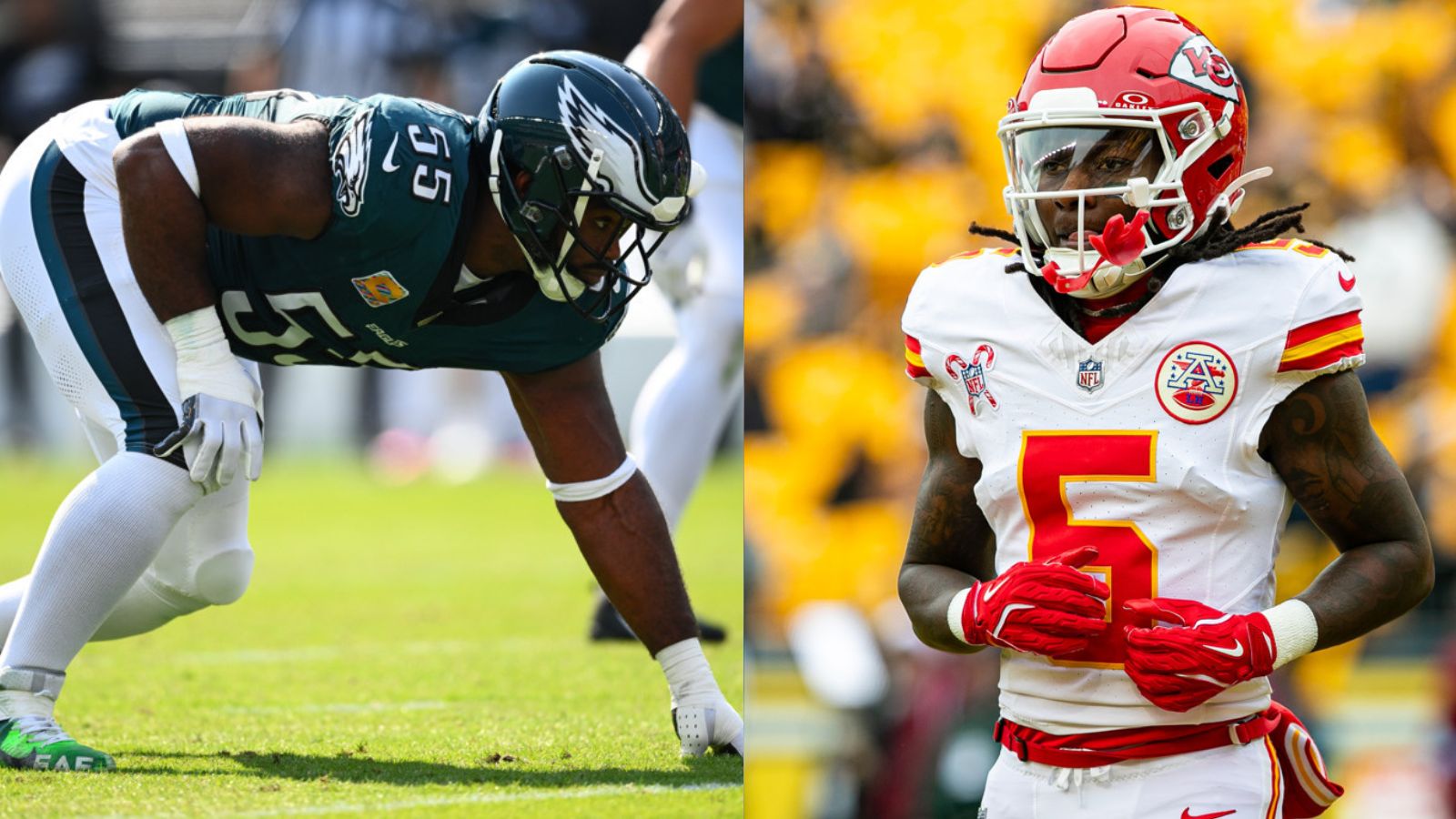Over the spring/summer, the SIS R&D staff is convening on the Off the Charts Podcast to talk about their top ten players at a position. To do this, we pit two methodologies against each other:
- The “Scouts,” which comes down to the film-based opinions of Matt Manocherian* and Bryce Rossler, each of whom has a lot of experience breaking down film and scouting players (Matt having done it for NFL teams).
- The “Stats,” which involves James Weaver and Alex Vigderman devising a ranking based on a suite of metrics, and having that ranking speak for itself.
*This week, Matt called for some backup, so we brought in Jeff Dean from our Football Ops department
Officially, Sports Info Solutions does not condone the dichotomy between scouting and statistical analysis. Each of them provides data in their own way and should inform our evaluation of a player.
When we originally produced the Football Rookie Handbook before transitioning that content to our NFL Draft site, we put the scouting reports and stats side-by-side with the idea that the reader would bounce back and forth between them and leverage both to come to a conclusion about a prospect.
So, without further ado, let’s get to these ‘Best Running Backs in the NFL’ lists and then do a deep dive on why each group ranked as it did.
| Scouts’ Opinion | Statistical Analysis |
| 1. Josh Jacobs | 1. Nick Chubb |
| 2. Christian McCaffrey | 2. Derrick Henry |
| 3. Nick Chubb | 3. Christian McCaffrey |
| 4. Derrick Henry | 4. Tony Pollard |
| 5. Jonathan Taylor | 5. Josh Jacobs |
| 6. Dalvin Cook | 6. Rhamondre Stevenson |
| 7. Rhamondre Stevenson | 7. Javonte Williams |
| 8. Aaron Jones | 8. A.J. Dillon |
| 9. Kenneth Walker III | 9. Aaron Jones |
| 10. Saquon Barkley | 10. Cordarrelle Patterson |
The Stats List Methodology
The stats-based ranking includes a two-year recency-weighted average of a player’s results across several different metrics, with the following weights applied to each:
- 35% Rushing Total Points
- 15% Receiving Total Points
- 5% Pass Blocking Total Points
- 10% Broken + Missed Tackle Rate
- 10% Heavy Box %
- 10% Positive% (when hit at the line)
- 5% Average Depth of Target
- 5% Positive% Balance – Gap/Zone
- 5% Positive% Balance – Inside/Outside
Once again, the stats team leans heavily into Total Points. This catch-all metric incorporates many of the elements that we would care about when evaluating a player’s performance. In this case, receiving impact is less relevant than rushing, but has a sizable impact for certain players in the Top 10. A key element of passing game impact for running backs is the ability to threaten the defense with more than just dump-offs, which is captured in Average Depth of Target.
Multiple stats measure the back’s ability to make people miss and to get past initial contact at the line. This is particularly relevant when the box is stacked, which is perhaps as relevant a contextual factor as any when it comes to rushing productivity.
The Positive% Balance stats take Positive%—the rate of successful plays from an EPA standpoint—and compare their performance across different splits. The players get rated on whichever is the lower of the two (gap vs. zone, or inside vs. outside). This basically gives credit to players who are good regardless of what they’re asked to do, as opposed to being a scheme specialist.
What the Stats Showed
4 out of the top 5 players on the stats list came in the Top 5 in Rushing Total Points. The outlier was Christian McCaffrey, who was the most productive receiver in the sample and ranked in the Top 3 on each list.
The player who stands out at the top of the stats-based list is Tony Pollard, who has been excellent in limited usage and exemplifies the challenge of evaluating running backs in this era. The Stats list ranked Pollard No. 4. The Scouts list did not put him in their Top 10. Often running backs are being given a limited scope of opportunities that helps them be successful, and it’s difficult to identify statistically if a player is only excelling because he’s being kept away from suboptimal run contexts.
Josh Jacobs was No. 5 on the Stats list and No. 1 on the Scouts list. He probably has the most polarizing statistical profile. He ranked in the Top 10 in Rushing Total Points, Broken + Missed Tackle Rate, and both Positive% Balance metrics. He ranked in the bottom half of the rest of the metrics.
The bottom half of the stats-based list was less solid due to questions about role, age, and health. No. 7 Javonte Williams was outstanding in 2021 and was set to have a good follow-up until he suffered a devastating knee injury. We elected to give him credit for what he did in a season-plus, acknowledging that it’s unlikely he maintains that performance going forward.
In that same vein, Cordarrelle Patterson makes the list at No. 10 in part because of excellent receiving production in 2021. His age and the direction of the roster make it extremely unlikely that he could make this list next year, but he was still acceptably productive as a rusher while seeing a ton of heavy boxes in an offense that struggled in the passing game.
Both Packers backs make the stats list, in an order that most people would probably disagree with. No. 8 A.J. Dillon had a much more successful 2021 than 2022 and failed to unseat No. 9 Aaron Jones in the way that some might have expected, producing a lot fewer eluded tackles than expected given his frame. But Jones has run into a lot of light boxes and didn’t differentiate himself in terms of passing game impact relative to Dillon.
What the Scouts Thought
The scouts were wowed by what their No. 1, Josh Jacobs, has put on film, not just in his 2022 campaign. Per Bryce, the things that stand out are his elusiveness and the contact balance. He’s extremely hard to tackle and runs with great leverage and tempo, and also brings speed in the open field.
Their second pick went to Christian McCaffrey, who stands out compared to the other top choices because of, as Jeff put it, his “gravity as a receiver,” with defenses having to account for him in multiple ways.
The scouts admit that their top three choices were pretty interchangeable, and that mostly aligns with how the stats list worked out.
No. 4 Derrick Henry falls just short of that group, in part because of his age (which proved to be a distinguishing factor between the lists, because the stats didn’t build in any sort of projection going forward). Bryce jokingly notes that his reduced broken and missed tackle rate compared to his reputation is partly because defenders just don’t want to get in his way once he builds up momentum.
The most notable discrepancies between the lists come in the middle of the scouts’ rundown, with Jonathan Taylor and Dalvin Cook.
Taylor came out 12th on the stats list because of a very unproductive 2022, but he cracks the scouts’ list at No. 5 as maybe one of the three best pure rushers in the league. He combines speed, vision, and elusiveness that few runners do, as shown in what he put on film in 2021. Jeff noted that the 2022 film was not great, but he gets a fresh start this year to show which of those two seasons to believe.
No. 6 Cook has been the topic of a lot of discussion with his release from the Vikings. According to Jeff (who just wrote an article about the flaws in Minnesota’s offseason plan), he brings breakaway ability that NFL teams value a lot, and he could be a bigger asset in the passing game for a team that uses him in more dynamic ways. He does have ball security issues at times and doesn’t always express that breakaway ability, but the tools are there to be a lead back.
The last name on the scouts’ list—Saquon Barkley—was debated on their end, which aligns with the stats in the sense that he does not have the statistical profile that his talent suggests.
Per Jeff, “The talent is obvious…when he’s on the field, he’s a difference maker. He’s a guy that provides value as both a receiver and a rusher, and when he’s in your backfield, you consider running back a ‘plus’ position.” Bryce pointed out that he’s gotten more disciplined as a runner—and the numbers back that up—which was a point of concern when he was coming out of college.
Overall, the lists aligned on six out of 10 players, with a couple players from each list being “off the board” for the other. However, four of the top five players on each list matched up, which says a lot for what those players have been able to put on film and the stat sheet the last couple years.
Want to hear more discussion and debate? Check out this episode of the podcast:



